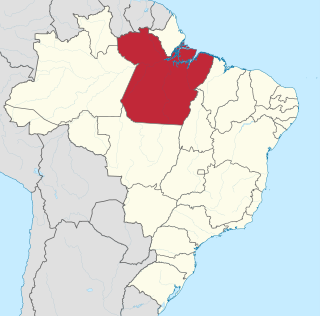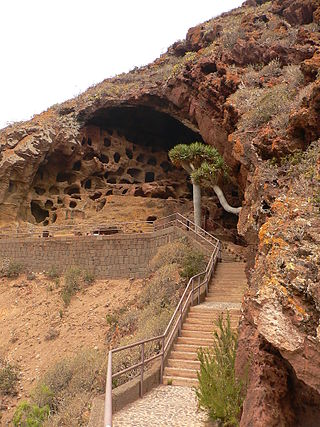Cueva Pintada typically refers to Painted Cave, Galdar. It may also refer to:
Cueva Pintada typically refers to Painted Cave, Galdar. It may also refer to:

Gáldar is a town and a Spanish municipality in the north of the island of Gran Canaria in the Province of Las Palmas in the Canary Islands. Its population is 24,227 (2013), and the area is 61.59 km2 (23.78 sq mi).
Below are notable events in archaeology that occurred in 1873.

José Carlos Somoza Ortega is a Spanish author. He was born in Havana, Cuba. In 1960 his family moved to Spain after being exiled for political reasons. His family proved to be in difficult financial situation after having moved to Spain because they had been forbidden to take anything along except their child. And there were a lot of friends who helped them a lot during their first years in Spain. He holds a Bachelor's Degree in psychiatry, but he gave up medicine in order to become a full-time writer in 1994. Since 1994 he made his first steps in writing and sent his works to the different literature competitions, to magazines and publishers all over Spain. And his first book was published the same year. When his fifth novel The Cave of Ideas obtained an international acknowledge, he realized that he had chosen the right route in his life.

Cueva de las Manos is a cave and complex of rock art sites in the province of Santa Cruz, Argentina, 163 km (101 mi) south of the town of Perito Moreno. It is named for the hundreds of paintings of hands stenciled, in multiple collages, on the rock walls. The art was created in several waves between 7,300 BC and 700 AD, during the Archaic period of pre-Columbian South America. The age of the paintings was calculated from the remains of bone pipes used for spraying the paint on the wall of the cave to create the artwork, radiocarbon dating of the artwork, and stratigraphic dating.

Joljaʼ is an archaeological site of the pre-Columbian Mayan civilization, located in the Chiapas highlands of central southern Mexico. Also known as Cueva de Jolja' in Spanish, the site is a cave which contains a painted mural and a number of inscriptions in the Mayan script which date back to the Early Classic period.
Crystal Cave may refer to:
Cuevas or Cueva may refer to:

Oxtotitlán is a natural rock shelter and archaeological site in Chilapa de Álvarez, Mexican state of Guerrero that contains murals linked to the Olmec motifs and iconography. Along with the nearby Juxtlahuaca cave, the Oxtotitlán rock paintings represent the "earliest sophisticated painted art known in Mesoamerica", thus far. Unlike Juxtlahuaca, however, the Oxtotitlán paintings are not deep in a cave system but rather occupy two shallow grottos on a cliff face.

Painting in the Americas before European colonization is the Precolumbian painting traditions of the Americas. Painting was a relatively widespread, popular and diverse means of communication and expression for both religious and utilitarian purpose throughout the regions of the Western Hemisphere. During the period before and after European exploration and settlement of the Americas; including North America, Central America, South America and the islands of the Caribbean, the Bahamas, the West Indies, the Antilles, the Lesser Antilles and other island groups, indigenous native cultures produced a wide variety of visual arts, including painting on textiles, hides, rock and cave surfaces, bodies especially faces, ceramics, architectural features including interior murals, wood panels, and other available surfaces. Many of the perishable surfaces, such as woven textiles, typically have not been preserved, but Precolumbian painting on ceramics, walls, and rocks have survived more frequently.

Caverna da Pedra Pintada, is an archaeological site in northern Brazil, with evidence of human presence dating ca. 11,200 years ago.

The Pedra Pintada or "Painted Rock", is a large rock located in the state of Roraima, Brazil. It is 85 metres long, 35 metres high and 30 metres wide, and is found in the Boa Vista savanna. There are many pictograms and other archaeological evidence inscribed on the walls of the rock.

Cueva de la Pileta is a cave in the province of Málaga, Spain, that was discovered in 1905 and contains cave paintings.
Pedra Furada is a collection of archaeological sites in the state of Piauí, Brazil.

The Parque nacional Cueva de las Maravillas is a national park located approximately 15 kilometres east from San Pedro de Macorís and 10 kilometres west from La Romana, in the south-eastern part of the Dominican Republic on the Caribbean island of Hispaniola.

Valerón's "monastery" is an archaeological site on the Spanish island of Grand Canary, in the municipality of Santa Maria de Guia, on Valerón's cliff. It is the largest pre-Hispanic collective granary built before Roman times and used by the island's inhabitants until the conquest of the island at the end of the 15th century.

The Painted cave is an archaeological museum and park in the town of Galdar, located the northwest of Grand Canary in the Canary Islands, Spain. This centre is part of the Spanish Ministry of Culture, Historic Heritage and Museums of the town council of Grand Canary.

The Four Doors site, also known as Montaña Bermeja, 'Vermillion Mountain', is a complex of caves in the south of the municipality of Telde, Gran Canaria.
The Monte Alegre State Park is a state park in the state of Pará, Brazil. The park covers a hilly region to the north of the Amazon River. It is known for its caves and prehistoric rock paintings, among the oldest archaeological remains in the Amazon region. Efforts have been made to get the local people involved in supporting sustainable tourism.

The Cave of Maltravieso in Cáceres, Extremadura, Spain, was discovered in 1951. It shows traces of human occupation from the Middle Paleolithic. It contains cave art, most notably a total of 71 hand stencils, enumerated in the 1990s using ultraviolet photography, but also linear designs and some animal paintings. In a 2018 study based on uranium-thorium dating, a hand stencil from the Cave of Maltravieso was dated to 64,000 years ago. This would make it Middle Paleolithic art, predating the presence of European early modern humans, with important implications for Neanderthal behavior.